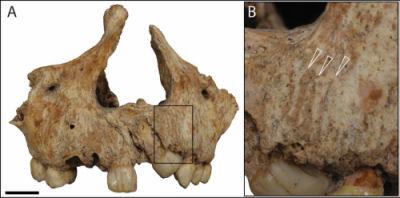Liverpool John Moores University
Source -http://phys.org/news/2014-06-lost-human-fossils.html
A treasure trove of important human fossils has been discovered by a team of scientists from the Natural History Museum, including Liverpool John Moores University's Dr Isabelle De Groote.
Future Ancient DNA analyses of these bones, morphological studies and further dating of the material may shed light on the exodus of modern humans from Africa and on whether the Middle East is the place where Neanderthals and modern humans met and interbred.
The collection consisted of boxes of bones discovered among the personal belongings of Sir Arthur Keith who had been the Master at Buckston Brown Farm, a research station of the Royal College of Surgeons next to Darwins home, Down House, Kent. After Sir Arthur Keiths death in 1955 a number of fossils were transferred from the collections at Royal College of Surgeons to the Natural History Museum but this particular collection did not arrive until 2001. It was not until the current study was carried out that the importance of Sir Arthur Keiths collection became clear. The study, published in Quaternary International, describes the work undertaken to identify and document the human skeletal material in the Keith Collection.

Map of sites from which the human fossils in the Keith Collection originate. Image by S M Bello
The study identified the human fossils as having come from a number of excavations directed by Dorothy Garrod in the 1920s and 1930s in what is now Israel. Dorothy Garrod was a female pioneer, the first woman to hold an Oxbridge Chair, and led a number of excavations at key archaeological sites in the Middle East such as Shukbah, El Wad, Tabun, Skhul and Kebara Caves. She relied on Sir Arthur Keith and Theodore McCown to carry out the morphological analyses of the skeletal material she discovered. Shukbah and El Wad were the first sites excavated and yielded primarily Late Upper Palaeolithic Natufian material which was briefly described by Garrod and Keith.

Shukbah cleaning damage. (A) Heavy damage on bone, probably due to post-excavation mechanical cleaning using a metal instrument. Scale 1 cm. (B) Detail of the damage; white arrows indicate the striation process probably associated to metal brushing
The older skeletal material belonging to Neanderthals and early modern humans was described by McCown and Keith in 1939 in the iconic volume The Stone Age of Mount Carmel. Detailed descriptions of most of the fossil material were included in the book and were the only testament to their existence.

Kebara D human fossil material: A. EM 3902. rt corpus mandibularis. B. EM 3903 corpus mandibularis. C. 3904. corpus mandibularis. D. EM 3901. corpus mandibularis. E. EM 3905. corpus mandibularis. F. EM 3907. Lt humerus. G. EM 3906. Lt humerus. H. EM 3910. Rt ulna. Photography: Charley Coleman
Dr Isabelle De Groote commented:
"We believe the collection became lost because the bombings of the Royal College of Surgeons in London made it necessary to transfer the material back to safety at Buckston Browne Farm, as well as McCowns move to Berkeley University, USA, in 1939."
Some of the fossils date back to a key time period where Neanderthals and modern humans may have co-existed in the Middle East and Europe. Very few early modern human fossils exist that date to the late Middle Palaeolithic and the material is therefore very significant. It has the potential to answer important questions about the dispersal of anatomically modern humans out of Africa.
Professor Chris Stringer, co-author and Research Leader in Human Origins at the Natural History Museum, adds:
"It's sometimes possible to make important finds through careful detective work on existing collections, rather than from new excavations, and this study is a great example of that. The material in question had been stored, unrecognised, for about 50 years until it arrived at the Museum in 2001. We now know that it not only contained the lost collection of modern human fossils from Shukbah Cave - the type site of the Natufian industry in Israel - but also some more fragmentary, but equally important, fossils that may cover the period of overlap between the last Neanderthals and the first modern humans in Israel, some 50,000 years ago."
More information: Isabelle De Groote, Silvia M. Bello, Robert Kruszynski, Tim Compton, Chris Stringer, "Sir Arthur Keith's Legacy: Re-discovering a lost collection of human fossils," Quaternary International, Available online 11 June 2014, ISSN 1040-6182, dx.doi.org/10.1016/j.quaint.2014.04.047